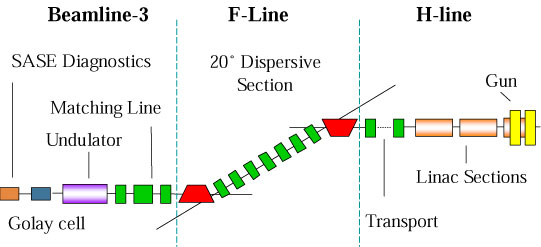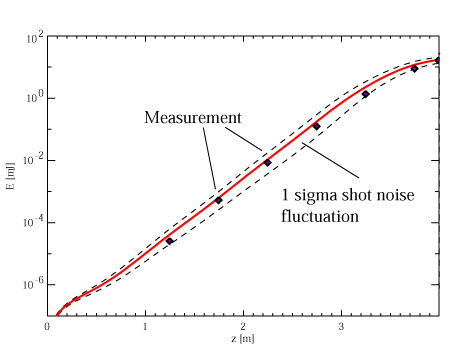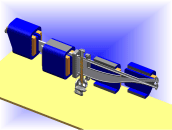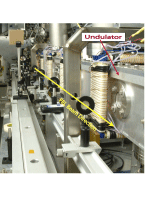Clicking on thumbnail opens image in new screen

Schematic of VISA Beamline

VISA I: Gain Curve

CAD Model of Chicane

Optical Transport Line

Optical Transport Line (reverse view)

Schematic of VISA Beamline

VISA I: Gain Curve

CAD Model of Chicane

Optical Transport Line

Optical Transport Line (reverse view)
VISA II is the follow on experimental program to the successful Visible to Infrared SASE Amplifier (VISA) experiment.
Experiment MissionTwo types of experiments SASE FEL experiments are foreseen using the VISA system: 1) An ultra-short gain length experiment, where the bunch is compressed in the chicane and dispersive beamline transport. Saturation should be achieved well before the undulator end, allowing studies of deep saturation wavelength and angular spectra, microbunching, statistical characteristics of output, harmonic generation; and, 2) Chirped beam experiments, where one imparts a time-frequency correlation on the FEL output through a time-energy correlation in the beam. By subsequent compression of the FEL light using gratings one may shorten the FEL output pulse. Other scenarios using chirped beams to create fsec pulses at the LCLS may be partially tested in VISA II.
The succesful VISA I experiment was designed to investigate physical properties of SASE-FEL as it relates to future LCLS operation. Saturation was achieved at 840 nm with a SASE power gain length of 17.9 cm and total gain of 108.
A novel bunch compression mechanism was developed during the VISA I experiment. This scheme utilized second order momentum error effects in the dispersive line. The proper choice of linac phase detuning and quadrupole settings yielded strong longitudinal bunch compression, and as a result, much higher current.
Another achievement of the VISA I experiment, was the development and deployment of a start-to-end (cathode to undulator) computational model. The computational effort involved employing UCLA-PARMELA for gun and linac calculations (emittance, charge, energy, energy spread), ELEGANT for transport lattice calculations (bunch length, beam size, emittance growth after dispersive line), and GENESIS 1.3 for undulator studies (gain length, saturation, angular wavelength, and spectra). This computational undertaking, compared with the detailed experimental data, yielded new levels of insight into the dynamics of SASE FEL processes. The same numerical tools will continue to be used for VISA II.

For a more detailed description of the experiment please refer to the VISA I Experiment page.